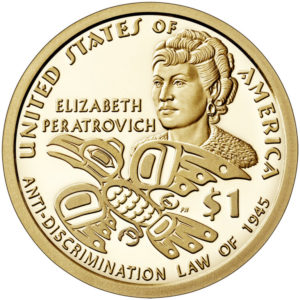
Who is Tlingit Native Elizabeth Peratrovich?
 Long before Malala Yousafzai won the Nobel Peace Prize, before feminists Gloria Steinem and Betty Friedan fought for women’s rights, and even before the Last Frontier’s statehood, a Tlingit woman named Elizabeth Peratrovich was advocating for Native rights. Her determination, along with that of her husband, led to passage of territorial Alaska’s Anti-Discrimination Act of 1945, the first law of its kind in the United States. The Act put an end to segregation in schools and made it illegal to discriminate against Native people at stores, restaurants, hotels, social clubs, and the like.
Long before Malala Yousafzai won the Nobel Peace Prize, before feminists Gloria Steinem and Betty Friedan fought for women’s rights, and even before the Last Frontier’s statehood, a Tlingit woman named Elizabeth Peratrovich was advocating for Native rights. Her determination, along with that of her husband, led to passage of territorial Alaska’s Anti-Discrimination Act of 1945, the first law of its kind in the United States. The Act put an end to segregation in schools and made it illegal to discriminate against Native people at stores, restaurants, hotels, social clubs, and the like.
In 1988, more than 40 years later, the state legislature honored the significance of Peratrovich’s revolutionary efforts by declaring February 16 – the day the law was enacted – Elizabeth Peratrovich Day in Alaska. Despite Peratrovich’s legendary status in Alaska, she’s been a relative unknown in the Lower 48 – something that’s changing as we celebrate the 75th anniversary of the Anti-Discrimination Act in 2020.
The U.S. Mint, this year, honors Peratrovich on a $1 coin. She is the first Alaska Native to be featured on U.S. currency. Patrick Hernandez, a U.S. Mint official, told CNN: “This coin will be a lasting tribute to Elizabeth Peratrovich and her relentless efforts to tear down the wall of discrimination against Alaskan Natives. We will proudly produce this coin that honors her bravery and determination.” Since the year 2000, the U.S. Mint has produced coins annually that highlight the historic influence of Native American individuals and tribes. The first $1 coin featured Sacagawea, the Shoshone woman who was a guide for Lewis and Clark. Sacagawea remains on the “head” of the coin. The coin’s “tail” design features a portrait of Peratrovich and a symbol of the Tlingit Raven moiety, or descent group.
In 2019, the New York Times featured Peratrovich in its Overlooked No More series of “remarkable people whose deaths, beginning in 1851, went unreported in the Times.” In an interview with the Times, Paulette Moreno, grand president of the Alaska Native Sisterhood, likened Peratrovich’s efforts to “house posts, the often beautifully carved structures upon which a traditional Tlingit house stands… Elizabeth and Roy have given us role models.”
Peratrovich’s legend also lives on in a newly published book for young adults, Fighter in Velvet Gloves. Annie Boochever, who authored the book with assistance from Roy Peratrovich Jr., Elizabeth’s only living child, told the e-magazine Unearth Women: “It is my hope that this book will inspire young readers to continue Elizabeth’s fight for the most important right in Alaska or anywhere else: the right to equal treatment under the law; no more, no less.” Boochever adds, “Elizabeth Peratrovich and her generation of Alaska Native leaders, planted the seeds of a civil rights revolution with their personal courage and commitment.”
As a Native owned company, Alaskan Dream Cruises takes pride in Elizabeth Peratrovich’s legacy, as well as in our Tlingit heritage. On each of our small-ship cruises, you’ll have an opportunity to immerse yourself in Southeast Alaska’s native history and culture. In fact, two of our newest itineraries on the Kruzof Explorer, Alaska’s Grand Coastal Discovery and our Remote Alaska Adventure, stop at Klawock, the village on Prince of Wales Island where Peratrovich spent much of her life. Begun by the Tlingit as a summer fishing camp, European Americans established a trading post and salmon saltery there in 1868. Klawock is notable for its 21 extraordinary totem poles.
There are remarkable sites on all of our itineraries, as well as exceptional winter specials and upgrades running through the end of February 2020. Be sure to check them out!


